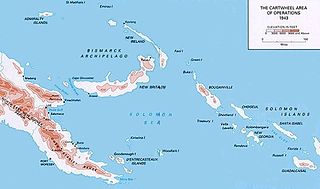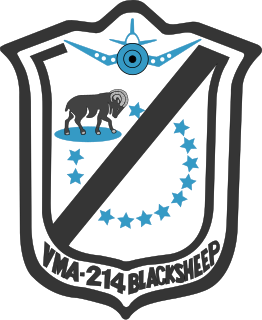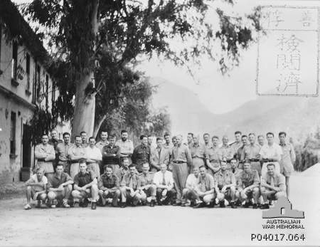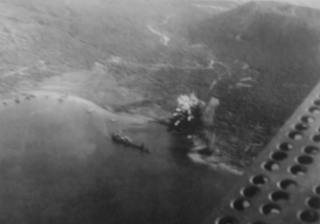Related Research Articles

Gregory "Pappy" Boyington was an American combat pilot who was a United States Marine Corps fighter ace during World War II. He received the Medal of Honor and the Navy Cross.

Operation Cartwheel (1943–1944) was a major military operation for the Allies in the Pacific theatre of World War II. Cartwheel was an operation aimed at neutralising the major Japanese base at Rabaul. The operation was directed by the Supreme Allied Commander in the South West Pacific Area (SWPA), General Douglas MacArthur, whose forces had advanced along the northeast coast of New Guinea and occupied nearby islands. Allied forces from the Pacific Ocean Areas command, under Admiral Chester W. Nimitz, advanced through the Solomon Islands toward Bougainville. The Allied forces involved were from Australia, the Netherlands, New Zealand, the US and various Pacific Islands.

The Battle of Rabaul, also known by the Japanese as Operation R, was fought on the island of New Britain in the Australian Territory of New Guinea, in January and February 1942. It was a strategically significant defeat of Allied forces by Japan in the Pacific campaign of World War II, with the Japanese invasion force quickly overwhelming the small Australian garrison, the majority of which was either killed or captured. Hostilities on the neighbouring island of New Ireland are usually considered to be part of the same battle. Rabaul was significant because of its proximity to the Japanese territory of the Caroline Islands, site of a major Imperial Japanese Navy base on Truk.
Eric M. Hammel was a military historian, with a focus on the military campaigns of the United States Marine Corps in the Pacific War, and other military action in World War II as well as military conflicts including the Vietnam War and the Arab-Israeli Conflict. Hammel wrote a series of books about World War II Flying Aces but his most influential book was The Root : The Marines in Beirut, August 1982-February 1984 on the subject of the 1983 Beirut barracks bombings.

Marine Attack Squadron 214 (VMA-214) is a United States Marine Corps fighter squadron consisting of AV-8B Harrier (V/STOL) jets. The squadron is based at Marine Corps Air Station Yuma, Arizona and is under the command of Marine Aircraft Group 13 (MAG-13) and the 3rd Marine Aircraft Wing.

Baa Baa Black Sheep is an American television series that aired on NBC from September 23, 1976, until April 6, 1978. It was part period military drama, part comedy. In the final seven episodes, the character list was revamped, dropping some squadron pilots, adding a 16-year-old pilot and four nurses.

Brigadier General Robert Edward Galer was a naval aviator in the United States Marine Corps who received the Medal of Honor for heroism in aerial combat during the Battle of Guadalcanal in World War II. He went on to command Marine Aircraft Group 12 during the Korean War and retired a few years after in 1957.
AirSols was a combined, joint command of Allied air units in the Solomon Islands campaign of World War II, from April 1943 to June 1944. It was subordinate to the Allied but U.S.-led Commander, South Pacific Area, itself part of Pacific Ocean Areas. AirSols superseded and absorbed the Cactus Air Force, which controlled Allied air units in the Solomons during 1942–43. AirSols was made up of United States Navy (USN), United States Marine Corps (USMC), the Royal New Zealand Air Force (RNZAF) and the Thirteenth Air Force, United States Army Air Forces (USAAF) forces.

Bruce Perry Crandall is a retired United States Army officer who received the Medal of Honor for his actions as a pilot during the Battle of Ia Drang on November 14, 1965, in South Vietnam. During the battle, he flew 22 missions in an unarmed helicopter into enemy fire to evacuate more than 70 wounded and bring ammunition and supplies to United States forces. By the end of the Vietnam War, he had flown more than 900 combat missions. He retired from the army as a lieutenant colonel and worked several jobs in different states before settling down with his wife in his home state of Washington.

John Franklin Bolt was a naval aviator in the United States Marine Corps and a decorated flying ace who served during World War II and the Korean War. He remains the only U.S. Marine to achieve ace status in two wars and was also the only Marine jet fighter ace. He rose to the rank of lieutenant colonel during his military career.

The 2/22nd Battalion was an infantry battalion of the Australian Army. Raised as part of the Second Australian Imperial Force for service during World War II, the battalion formed part of the 23rd Brigade, attached to the 8th Division. It was captured by the Japanese during the Battle of Rabaul in 1942. After being captured, the battalion was not re-raised and a large number of its personnel died in captivity; those that did not were returned to Australia at the end of the war in 1945.

Operation I-Go was an aerial counter-offensive launched by Imperial Japanese forces against Allied forces during the Solomon Islands and New Guinea Campaigns in the Pacific Theater of World War II. Taking place from 1–16 April 1943, during the operation, Japanese aircraft – primarily from Imperial Japanese Navy units under the command of Admirals Isoroku Yamamoto and Jinichi Kusaka – attacked Allied ships, aircraft, and land installations in the southeast Solomon Islands and New Guinea. The goal of the operation was to halt the Allied offensives in New Guinea and the Solomons and to give Japan time to prepare a new set of defenses in response to recent defeats to the Allies in the Battle of Guadalcanal and in New Guinea at Buna–Gona, Wau, and the Bismarck Sea.

Christopher Lyman Magee was a United States Marine Corps aviator who became a fighter ace in World War II and was one of the more colorful members of the famous "Black Sheep" squadron, VMF-214. Known as a fearless and aggressive pilot he was credited with nine victories during the war, and for his heroic actions in September and October 1943 during the Solomon Islands campaign he was awarded the Navy Cross. After the war, he dabbled in bootlegging, went to Israel and flew with the Haganah during the 1948 Arab–Israeli War and later served 81⁄2 years in federal prison for bank robberies in the Chicago area. Upon his return from prison, he lived quietly on the North Side of Chicago working as a columnist and reporter for a community newspaper. He died of surgical complications while having stomach cancer tumors removed on December 27, 1995.

Ataliklikun Bay is a bay of East New Britain Province, Papua New Guinea, opening into the Bismarck Sea. It is located in the northern part of New Britain, south-west of Lassul Bay and to the west of Cape Lambert and Rabaul. Urara Island is located in the northern part of the bay. The Raulavat plantation lies in the eastern part of its 25-mile shoreline. The villagers along the shore reportedly speak the Minigir language and the Masava dialect of Tolai. The United States Hydrographic Office said "a reef awash, about 200 yards long east and west, with 15 and 19 fathoms around, on which the steamer Seestem struck in 1909, lies in the south-west part of Ataliklikun Bay."
Toshiharu Sakigawa was a Japanese lieutenant colonel. He is best known for leading a mechanized unit in January 1942, during World War II in which he attacked the Australians on the north coast of New Britain at Rabaul and Ataliklikun Bay during the Battle of Rabaul.

Rabaul is a town in Eastern New Britain, Papua New Guinea. Japanese forces landed on Rabaul on 23 February 1942, capturing it in February of that year. The former Australian territory was transformed into a major Japanese naval and air installation. The Japanese heavily relied on it, and used it as a launching point for Japanese reinforcements to New Guinea and Guadalcanal. Throughout the Solomons Campaign, neutralizing Rabaul became the primary objective of the Allied effort in the Solomons.

Marine Fighting Squadron 213 (VMF-213) was a reserve fighter squadron in the United States Marine Corps. Nicknamed the "Hell Hawks", the squadron fought during World War II in the Philippines and at the battles of Iwo Jima and Okinawa. With its assignment to the USS Essex (CV-9) and Air Group 4, VMF-213 along with VMF-124 was one of the first two Marine squadrons to augment carrier air groups during World War II. The squadron was credited with downing 117 enemy aircraft during the war.

James Tillinghast Moore was a decorated aviation officer of the United States Marine Corps with the rank of lieutenant general. He is most noted for his service as commanding officer of the 2nd Marine Aircraft Wing during World War II.
John F. Wukovits is a military historian, who specializes in the Pacific theater during World War II.
References
- 1 2 3 4 5 6 7 Simmons, Tony (1 December 2013). "Local author's WWII trilogy reaches thrilling conclusion". Panama City News Herald. Panama City. Archived from the original on 18 March 2015. Retrieved 18 March 2015.
- 1 2 "Featuring John Rizzo and Bruce Gamble". The Law Business Insider. 5 May 2015. Archived from the original on 8 March 2015. Retrieved 18 March 2015.
- 1 2 3 "Details: Military Writer's Society of American Conference, Bruce Gamble". Positively Pittsburgh Live Magazine Videos. 18 October 2010. Retrieved 18 March 2015.
- 1 2 3 4 "Bruce Gamble- Author Interview". Pacific Wrecks. 18 February 2014. Retrieved 18 March 2015.
- 1 2 "Meet author Bruce Gamble for a book signing session at..." Warbird News. 10 October 2013. Retrieved 18 March 2015.